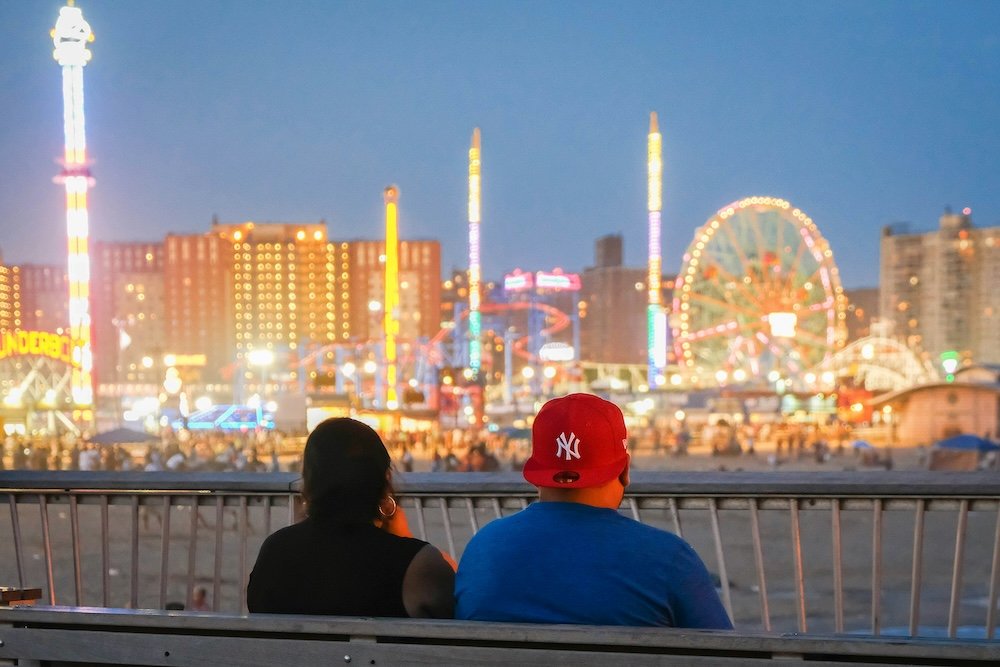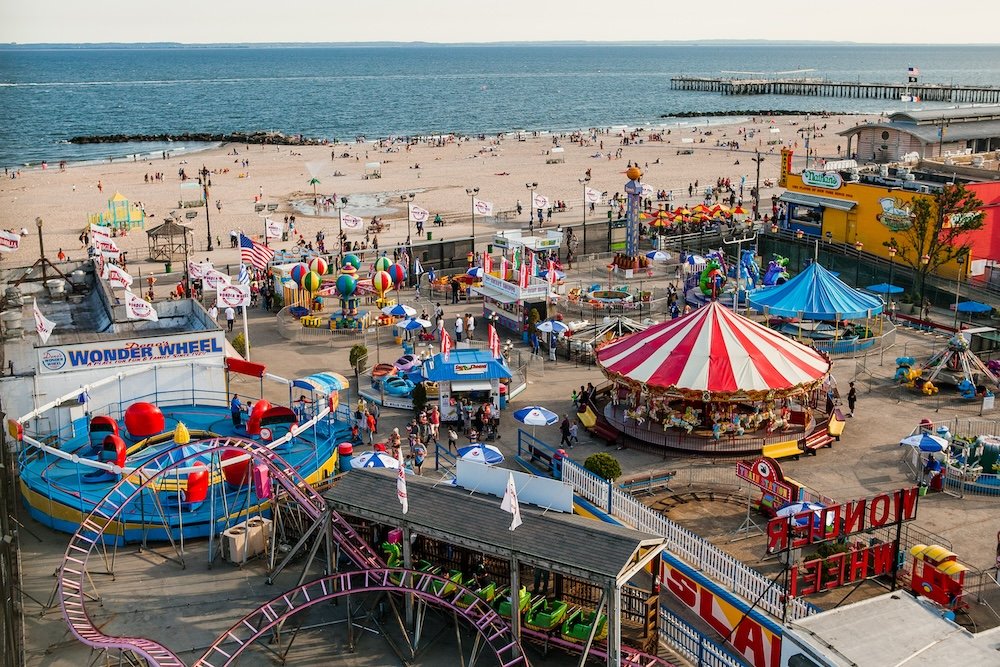
Coney Island, a name synonymous with New York City’s vibrant history and cultural tapestry, stands as an iconic seaside landmark that has captivated the hearts of millions.
Nestled on the southern tip of Brooklyn, it has long been a melting pot of excitement, innovation, and charm.
From its humble beginnings as a remote shoreline dotted with small hotels and clam bars, Coney Island evolved into a bustling entertainment hub, famous for pioneering the American amusement park industry.
Today, Coney Island still thrills visitors with its blend of old-world charm and modern attractions, maintaining its status as a timeless symbol of New York City’s spirit of fun and relaxation.
Yet, beyond the well-trodden boardwalk and historic amusement rides lie stories and facts that many may not know.
This article peels back the layers of Coney Island’s storied past and present, offering a deeper look into 11 interesting facts that highlight why this place remains a cornerstone of New York’s cultural heritage.
Join us as we explore the lesser-known tales of innovation, entertainment, and community that define Coney Island.
From its curious name origins to its pivotal role in the birth of the American amusement industry, each fact promises to enrich your understanding and appreciation of this beloved New York landmark.
Whether you’re a history buff, thrill-seeker, or simply a lover of all things New York, there’s something in this journey through Coney Island’s past and present for everyone.
Fact 1: The Origin of the Name “Coney Island”
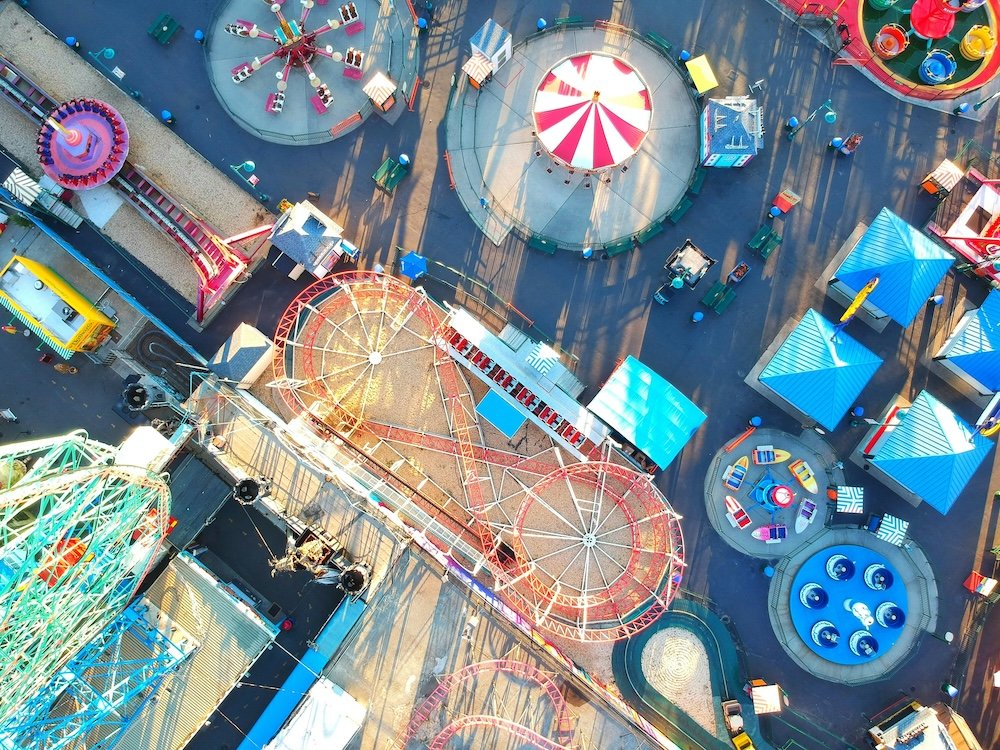
The name “Coney Island” is steeped in as much mystery as the area itself is steeped in history.
Several theories exist regarding how this iconic spot received its unique name, each adding a layer to the rich tapestry of New York’s past.
One of the most widely accepted theories traces back to the area’s early Dutch settlers.
The original Dutch name, “Conyne Eylandt,” literally means “Rabbit Island” in English.
This name was likely chosen due to the large population of wild rabbits that the early European settlers observed on the island, making it a notable feature of the landscape.
Historical documents, including old maps and writings, show variations of the name such as “Conney Isle,” “Conney Hook,” and “Conine Island,” which all suggest a linguistic evolution from the Dutch word “konijn,” meaning rabbit.
These rabbits weren’t just a fleeting detail in the area’s ecology but were a significant source of food and fur for the Native American populations and later European settlers, underscoring the practical importance of the area long before it became known for its amusement parks.
Moreover, there’s a romantic aura to the idea that Coney Island’s name could reflect a lost era when it was a quieter, more natural place, teeming with wildlife, which contrasts sharply with the bustling amusement district it would become.
This connection to nature might seem surprising today, considering the island’s current reputation as a hub of vibrant human activity rather than wildlife.
Thus, the name “Coney Island” serves as a lasting nod to the island’s wild origins and a reminder of how deeply New York’s history is intertwined with both its natural and human-crafted environments.
As we dive deeper into the lesser-known aspects of Coney Island, each story and fact reveals layers of transformation that have shaped this New York landmark into the cultural icon it is today.
Fact 2: Coney Island’s Early History as a Resort Destination

Long before Coney Island became synonymous with colorful amusement parks and bustling beaches, it was a remote barrier island, characterized by its natural landscapes and tranquil shores.
The transformation of Coney Island into a premier resort destination in the early 19th century is a pivotal chapter in its storied past, marking the beginning of its journey into the heart of American leisure culture.
In the early 1800s, Coney Island was largely undeveloped, its expansive beaches and unspoiled nature making it a perfect getaway from the burgeoning urban sprawl of nearby Manhattan.
Recognizing the potential of this seaside locale, entrepreneurs began to invest in the area.
The first significant step towards its transformation was the construction of the Coney Island Hotel in 1829.
This establishment offered visitors a chance to escape the city’s heat and chaos in favor of the soothing breezes and scenic views of the Atlantic Ocean.
The accessibility of Coney Island dramatically improved with the introduction of steamboat services and later, the completion of railroads linking it directly to Brooklyn and Manhattan.
These developments made day trips to the island feasible and affordable for the working and middle classes, democratizing access to leisure activities that were once the preserve of the wealthy.
By the mid-19th century, Coney Island had blossomed into a thriving resort area, complete with elegant hotels, racetracks, and bathing pavilions that attracted scores of visitors.
The establishment of amusement parks, which began in the latter part of the 19th century, shifted Coney Island’s appeal from a quiet resort town to a bustling hub of entertainment.
The creation of attractions like the Elephant Hotel, which featured a giant elephant-shaped building that visitors could explore, further solidified its reputation as a place where novelty and excitement awaited all who visited.
The allure of Coney Island during this era was not merely in its entertainment options but also in its role as a social melting pot.
It was a place where people from all walks of life could mingle, relax, and be entertained, contributing to the democratic, inclusive spirit that would define its cultural status for generations to come.
The early history of Coney Island as a resort destination set the stage for its later fame as the playground of New York, showing how a once-remote barrier island transformed into a cornerstone of American recreational life.
This transition was not just about the evolution of the landscape but also about the changing American attitudes towards leisure, making Coney Island a significant historical symbol in the narrative of New York and the nation.
Fact 3: The Invention of the Hot Dog at Coney Island

Coney Island is not just a landmark in American entertainment but also a pivotal site in American culinary history.
It is credited with the invention of one of the nation’s most beloved street foods: the hot dog.
This seemingly simple dish has a storied past that begins with a German immigrant named Charles Feltman, who played a critical role in turning a European sausage tradition into an American icon.
In the summer of 1867, Charles Feltman, a German baker, arrived at Coney Island with a pushcart and a dream.
He started by selling pies and milk rolls, but he soon had a visionary idea that would leave a lasting impact on American cuisine.
Understanding the needs of the many visitors who flocked to the island looking for convenient and quick eating options, Feltman began to sell sausages in rolls.
These were not just any sausages but German-style frankfurters, which were easy to eat while strolling along the boardwalk.
Feltman’s innovation was to place the sausage inside a split bun, reportedly to avoid the necessity of providing plates and cutlery to his customers.
This simple yet effective solution allowed visitors to enjoy a hearty meal without interrupting their leisurely walks along the beach.
The idea was an instant hit, making the hot dog synonymous with seaside snacks and eventually, American fast food.
By 1871, Feltman had expanded from a humble pushcart to a full-fledged restaurant on Coney Island called Feltman’s Ocean Pavilion.
This restaurant grew into a large complex of dining rooms, beer gardens, and amusements, serving as many as five million people a year at its peak.
The popularity of Feltman’s hot dogs grew exponentially; it is said that he sold 3,684,000 hot dogs in his restaurant’s first year alone.
The widespread appeal of the hot dog led to further popularization when one of Feltman’s employees, Nathan Handwerker, started his own hot dog stand in 1916, which became the famous Nathan’s Famous, a landmark that still stands on Coney Island today.
Nathan’s was able to undercut Feltman by selling hot dogs for half the price, leading to its own legendary status and further cementing the hot dog as a staple of Coney Island and American food culture.
Thus, the invention of the hot dog at Coney Island is not merely a culinary anecdote but a testament to the ingenuity of immigrant entrepreneurs who shaped American culture.
It reflects the spirit of innovation and accessibility that Coney Island has embodied since its transformation into a resort destination.
Today, the hot dog remains a symbol of American cuisine, a reminder of its roots in the diverse cultures that continue to shape it.
Fact 4: The Birthplace of the American Roller Coaster
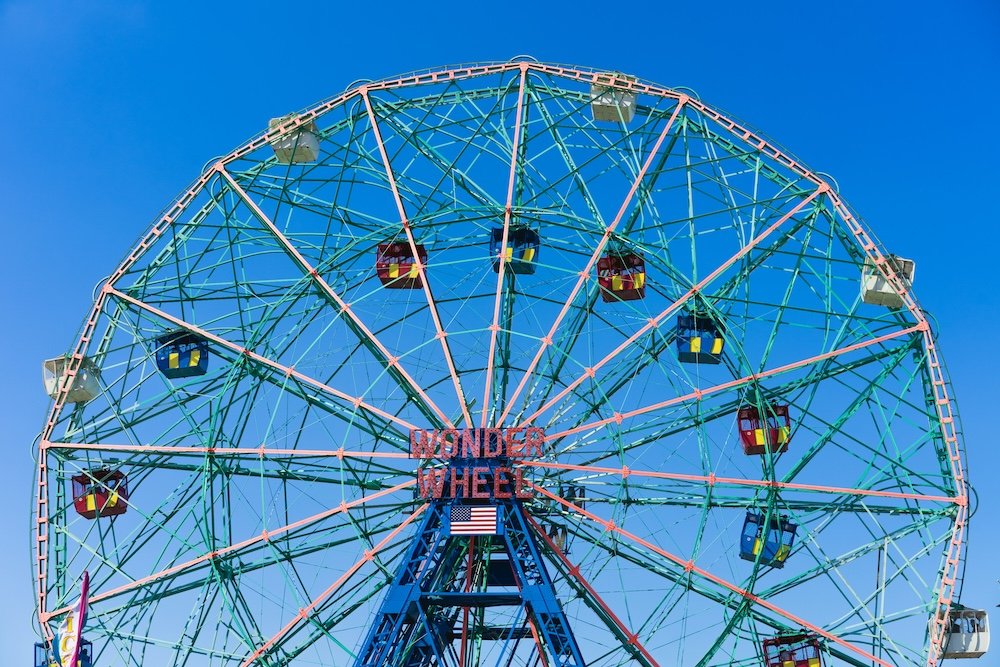
Coney Island not only reshaped America’s culinary landscape but also its recreational and entertainment industry.
One of the most thrilling contributions was the birth of the American roller coaster, which began with the introduction of the Switchback Railway in 1884.
This iconic ride marked a turning point in amusement park history and established Coney Island as a pioneer in the field of thrill-seeking entertainment.
The Switchback Railway was the brainchild of LaMarcus Adna Thompson, often referred to as the “Father of the American Roller Coaster.”
Thompson was inspired by the Mauch Chunk Switchback Railway, a coal-transporting railroad in Pennsylvania that had become a scenic ride for pleasure-seekers.
Seeing the potential for such a ride as a leisure attraction, Thompson designed a version that was suited for Coney Island’s bustling environment.
The Switchback Railway was relatively simple by modern standards but revolutionary at the time.
It consisted of a 600-foot track that rose to a height of 50 feet, on which a bench-like car carrying passengers would glide along under gravity’s pull, after being manually pushed up the first hill.
The car would then travel down the track to the opposite end, where it would be switched to a return track and repeat the journey back to the starting point.
The ride was slow and gentle, especially compared to today’s high-speed roller coasters, but it provided a novel sensation that was enough to thrill 19th-century thrill-seekers.
This new form of entertainment was an immediate success, with rides costing five cents and offering many visitors their first experience of controlled, mechanical thrill.
The introduction of the Switchback Railway not only popularized the roller coaster concept but also spurred a wave of innovation across amusement parks nationwide.
Other inventors and entrepreneurs began to develop more elaborate and thrilling designs, each trying to capture the excitement and success of Thompson’s original concept.
The development of the roller coaster at Coney Island thus marked a significant evolution in amusement rides, reflecting a broader trend towards mechanized entertainment that could draw large crowds and provide new forms of leisure activity.
It set the stage for the future of amusement parks that would prioritize bigger, faster, and more exhilarating rides, continually pushing the boundaries of what was possible in entertainment technology.
Today, while roller coasters around the world have evolved far beyond what Thompson could have imagined, the legacy of the Switchback Railway lives on.
It reminds us of Coney Island’s role as a harbinger of amusement innovation, continually redefining the limits of excitement and entertainment for generations of visitors.
Fact 5: Coney Island’s Role in Technological Innovations in Entertainment
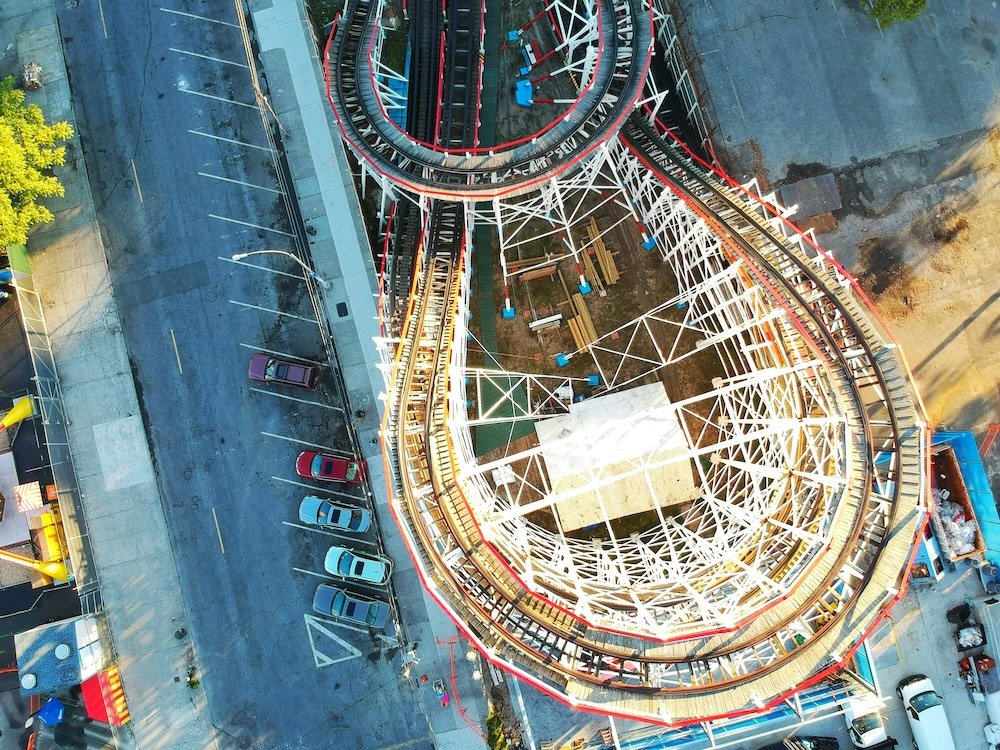
Coney Island has not only been a hub of amusement and recreation but also a pioneering ground for technological innovations in entertainment.
Over the years, it has served as a testing ground for numerous new technologies, particularly during the height of its popularity in the late 19th and early 20th centuries.
One of the most significant innovations was the early use of electricity in amusement rides, which transformed the nighttime landscape and visitor experience at Coney Island.
The electrification of Coney Island began in earnest with the opening of Luna Park in 1903.
This park was one of the first in the world to be fully powered by electricity, which allowed it to offer extended hours of operation into the night.
The park’s creators, Frederic Thompson and Elmer “Skip” Dundy, utilized thousands of electric lights to illuminate the park’s buildings, rides, and walkways, creating a dazzling spectacle that had never been seen before.
This use of electric light not only enhanced the aesthetic appeal of the park but also symbolized the dawn of a new era in amusement technology.
The success of Luna Park inspired other parks to adopt similar technologies.
Dreamland, another iconic Coney Island park, opened in 1904 and took the use of electricity even further.
It featured more elaborate electrical displays and used technology not just for lighting but also for powering rides and attractions.
One of the most technologically advanced features of Dreamland was the use of underwater lights, which were a novelty at the time and added an otherworldly glow to its large water rides and shows.
Beyond lighting, Coney Island also experimented with other forms of entertainment technology.
The introduction of moving pictures and early cinematic experiences were also part of the attractions, with theatres and shows incorporating the latest in visual technology to captivate audiences.
These innovations were critical in making Coney Island a cutting-edge entertainment destination, where visitors could experience the future of leisure activities.
The role of Coney Island in these technological advancements extended beyond mere amusement; it played a significant part in popularizing these technologies.
The public’s acceptance and enjoyment of these electrified parks showed entrepreneurs and inventors alike that there was commercial viability in the leisure applications of new technologies.
This acceptance helped spur wider adoption of electrical power and other innovations in cities across America and around the world.
Coney Island’s contribution to technological innovations in entertainment is a testament to its role as a leader in the amusement industry.
Its history of embracing and promoting new technologies not only changed the face of amusement parks but also influenced broader cultural attitudes towards technology and progress.
Through its bold experiments, Coney Island helped forge a path that would lead to the modern, technology-driven entertainment experiences we enjoy today.
Fact 6: The Heyday of Coney Island in the Early 20th Century
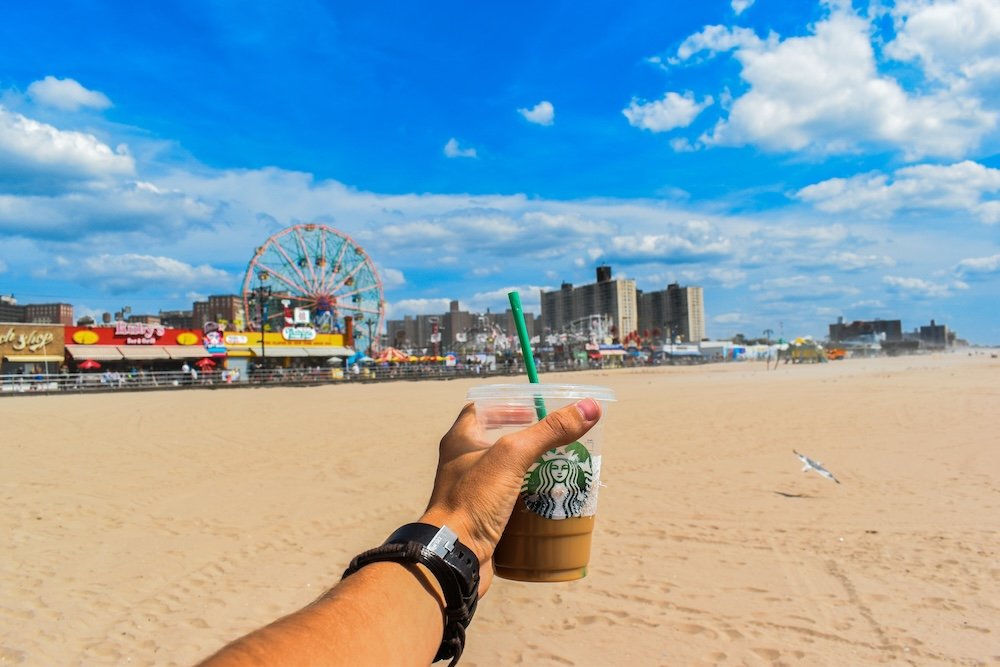
The early 20th century marked the golden age of Coney Island, as it blossomed into the epitome of amusement and leisure, not just for New Yorkers but for millions of visitors from around the world.
This period is best encapsulated by the triumvirate of grand amusement parks that defined its landscape: Luna Park, Dreamland, and Steeplechase Park.
Each park brought its own unique flavor and innovation to the Coney Island experience, contributing to a vibrant atmosphere that became legendary.
Luna Park: Opened in 1903 by Frederic Thompson and Elmer “Skip” Dundy, Luna Park was a marvel of electric lights and architectural grandeur. Known for its exotic architecture and thousands of electric bulbs that lit up the night sky, Luna Park was more than an amusement park; it was a fantasy land. Its attractions included rides like the “Shoot-the-Chutes” water flume and the “Dragon’s Gorge” scenic railway, alongside spectacular shows and performances that drew crowds in the thousands. The park’s use of themed areas, each designed to transport visitors to a different world, set a new standard for immersive entertainment.
Dreamland: Following Luna Park’s success, Dreamland was opened in 1904 and quickly became known for its larger, more elaborate attractions and its emphasis on education and spectacle. Dreamland featured everything from a miniature railway to a replica of the Panama Canal. Its most famous attraction, however, was the “Hell Gate,” a boat ride through whirlpools and geysers that simulated a boat trip through tumultuous waters. Dreamland was also notable for its pioneering use of lighting, including underwater lights that added an ethereal quality to its night-time ambiance.
Steeplechase Park: Founded by George C. Tilyou in 1897, Steeplechase Park offered a different kind of fun, with a focus on interactive, participatory attractions. It was best known for the Steeplechase ride, where riders mounted horses attached to steel tracks and raced against one another, a precursor to the modern roller coaster. The park also featured the “Funny Face” logo, which became an iconic symbol of Coney Island’s whimsical spirit. Steeplechase Park was less about spectacle and more about direct engagement, with numerous games, obstacle courses, and comedic performances that encouraged visitors to become part of the entertainment.
The synergy created by these three amusement parks during Coney Island’s heyday in the early 20th century was unparalleled.
This era saw Coney Island at its peak, with its blend of innovation, fantasy, and community drawing in upwards of a million visitors on hot summer days.
The parks were not just places of amusement but cultural melting pots where people from all walks of life could mingle, enjoy, and escape the routine of daily life.
Despite facing various challenges including fires, the economic impact of the Great Depression, and changes in public leisure habits, the legacy of this golden age continues to define Coney Island.
The spirit of innovation and universal appeal during these years set the stage for the enduring popularity of Coney Island as a pivotal American entertainment landmark.
Fact 7: Coney Island’s Decline and Revival Efforts
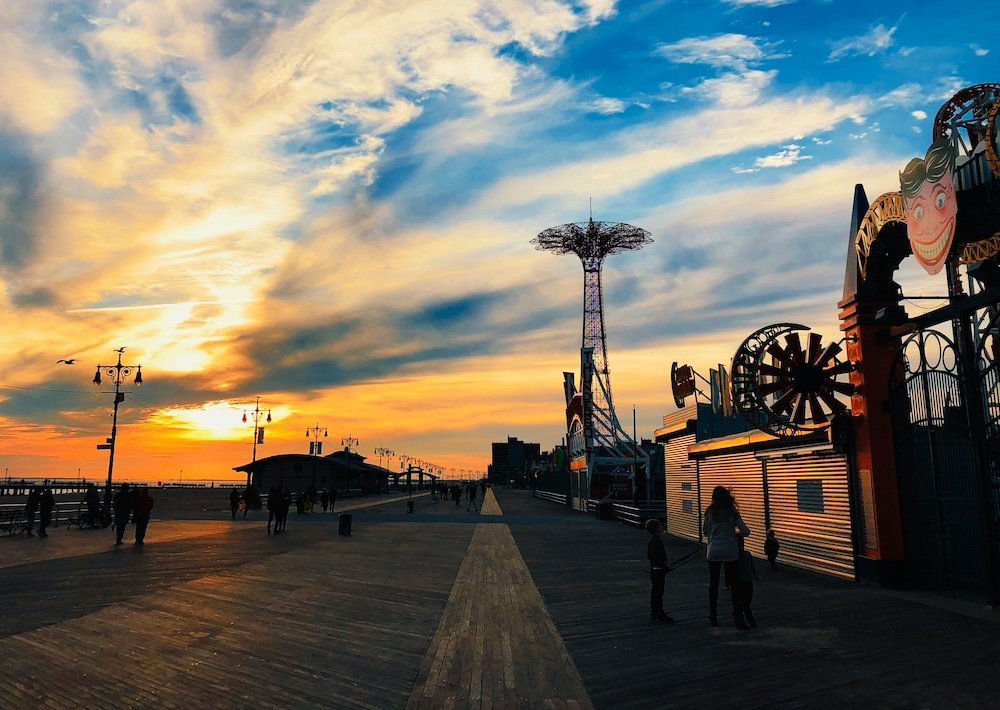
After the glittering heights of its early 20th-century heyday, Coney Island faced a period of decline that began in the years following World War II.
Several factors contributed to this downturn, including the advent of air conditioning, which made staying indoors during summer more appealing, and the rise of car culture, which made more distant destinations accessible for leisure and vacations.
Economic challenges and changing social conditions also led to neglect and disinvestment in the area, causing some of the iconic parks to deteriorate and eventually close.
The Decline: During the 1940s and 1950s, Coney Island began to lose its luster. The once-bustling Luna Park closed in 1946 after a devastating fire, and Dreamland had already been lost to fire in 1911 and was never rebuilt. Steeplechase Park continued to operate until 1964, but it too eventually succumbed to economic pressures and changing tastes. The closure of these parks marked the end of an era for Coney Island. The area became associated with crime and decay in the 1970s and 1980s, a far cry from its status as a jewel of New York entertainment.
The Revival Efforts: The revival of Coney Island began in earnest in the late 1990s and early 2000s, as city planners, developers, and local activists started pushing for redevelopment and investment in the area. Key to these efforts was the recognition of Coney Island’s historical and cultural significance, as well as its potential as a year-round entertainment destination.
In 2001, the opening of KeySpan Park (now known as Maimonides Park), home to the minor league baseball team the Brooklyn Cyclones, marked a significant step forward in the area’s revival.
This development brought new energy and visitors to Coney Island, helping to stabilize the neighborhood.
Further bolstering these efforts, the city launched comprehensive plans to rejuvenate the area, focusing on improving infrastructure, enhancing public spaces, and attracting new businesses.
In 2010, the Luna Park amusement park was reopened on the site of the former Astroland, bringing back a name filled with nostalgia and promising a new future for the amusement district.
The new Luna Park featured modern rides and attractions, including the Thunderbolt roller coaster and the Scream Zone, blending nods to the past with contemporary thrill rides.
Another significant aspect of the revival has been the restoration and reopening of historic rides and attractions. T
he B&B Carousell, one of Coney Island’s oldest carousels, was meticulously restored and reopened in 2013, and the Parachute Jump, although no longer operational as a ride, was refurbished and relit as a symbol of Coney Island’s resilience.
The Continuing Revival: Today, Coney Island stands as a vibrant blend of old and new, where historical attractions and new innovations coexist. Annual events like the Mermaid Parade and the Nathan’s Famous Hot Dog Eating Contest continue to draw crowds, cementing Coney Island’s place as a cultural and entertainment hub. The ongoing efforts to revitalize the area ensure that it remains a significant part of New York’s cultural fabric, honoring its rich history while looking forward to a bright future.
Fact 8: Coney Island as a Filmmaking Location
Coney Island’s vibrant atmosphere and scenic landscapes have made it an alluring setting for filmmakers, solidifying its status as an iconic location in popular culture.
Its amusement parks, bustling boardwalk, and sandy beaches have served as the backdrop for numerous films and television shows, each capturing different facets of its unique character.
Classic Films: One of the earliest films set in Coney Island is the silent short Coney Island (1917), starring Fatty Arbuckle and Buster Keaton, which showcases the amusement parks and lively beach scenes of its era. Another classic, The Little Fugitive (1953), uses Coney Island to depict a child’s adventure in New York, highlighting the sense of wonder the park inspires in visitors of all ages. This film, in particular, influenced the French New Wave filmmakers and showcased the potential of Coney Island as a cinematic canvas.
Modern Depictions: In more recent years, Coney Island has featured prominently in films that explore deeper themes using its iconic elements as metaphors. Darren Aronofsky’s Requiem for a Dream (2000) and Woody Allen’s Wonder Wheel (2017) both paint a gritty and emotional portrait of life in and around the Coney Island area, tapping into its complex history and the nostalgia of its amusement parks.
Television Shows: Television has also turned to Coney Island as a vibrant locale that adds authenticity and charm to various narratives. Shows like Mr. Robot have used the area to great effect, capturing its off-season, melancholic ambiance to reflect the show’s darker, more introspective themes. Boardwalk Empire, although primarily set in Atlantic City, included scenes that were shot at Coney Island, utilizing its historic feel to recreate the Prohibition era accurately.
Music Videos and Documentaries: Beyond narrative film and television, Coney Island has starred in numerous music videos and documentaries that explore or celebrate New York City culture. These productions often highlight the area’s energetic summer vibe, featuring its amusement rides and boardwalk as symbols of leisure and escape within the urban landscape.
Coney Island’s appeal as a filmmaking location lies not just in its physical beauty and nostalgic charm but also in its ability to represent different aspects of the human experience, from joy and wonder to despair and resilience.
Its presence in film and television has helped immortalize Coney Island, ensuring its place not only in the physical realm but also in the imaginations of viewers worldwide.
Through the lens of popular media, Coney Island continues to captivate and enchant, maintaining its role as a cultural and cinematic landmark.
Fact 9: The Mermaid Parade
The Mermaid Parade is one of Coney Island’s most colorful and celebrated traditions, an annual event that epitomizes the creative and communal spirit of this iconic New York landmark.
Established in 1983 by Coney Island USA, a nonprofit arts organization, the parade aims to preserve the unique artistic heritage of the community while fostering an appreciation for the diverse cultures that enrich the area.
History and Significance: The Mermaid Parade was conceived as a homage to the Coney Island Mardi Gras parades held in the early 20th century, which had been a major attraction until their discontinuation in 1954. The revival of this spirited tradition in the form of the Mermaid Parade provided an opportunity for New Yorkers to express their artistic creativity and engage with the local community in a festive, inclusive environment. The parade also serves as a celebration of the arrival of the summer season, combining seaside themes with mythological and marine elements.
What It Entails: Participants in the Mermaid Parade adorn themselves in handcrafted costumes, often inspired by mermaids, sea creatures, and nautical mythology, creating a spectacular display of imagination and craftsmanship. The parade features a wide array of characters, from Neptune and mermaids to sea monsters and sailors, making their way along the Surf Avenue and the boardwalk, cheered on by tens of thousands of spectators. It is known for its exuberant atmosphere and vibrant visuals, which include elaborate floats and vintage automobiles.
In addition to being a visually stunning event, the Mermaid Parade is deeply symbolic of Coney Island’s enduring spirit of eccentricity and artistic freedom.
It embodies the community’s resilience and creativity, acting as both a nod to the past and a celebration of contemporary cultural expressions.
The parade is inclusive, inviting participants of all ages and backgrounds to join in the festivities, which culminates in the crowning of a Mermaid Queen and King Neptune, typically local celebrities or community figures who have contributed significantly to the spirit of Coney Island.
Cultural Impact: The Mermaid Parade has grown to become not only the largest art parade in the United States but also a critical public event for Coney Island, drawing attention and visitors to the area each year. It plays a crucial role in the local economy and cultural landscape, supporting artists, performers, and small businesses. Moreover, it highlights Coney Island’s unique blend of historical significance and contemporary culture, reinforcing its status as a place of celebration, creativity, and community.
As a result, the Mermaid Parade is more than just an annual event; it is a vital tradition that continues to contribute to the cultural vibrancy and communal identity of Coney Island, ensuring that this historic amusement zone remains a beloved and dynamic fixture of New York City’s cultural scene.
Fact 10: Unique Architectural Features
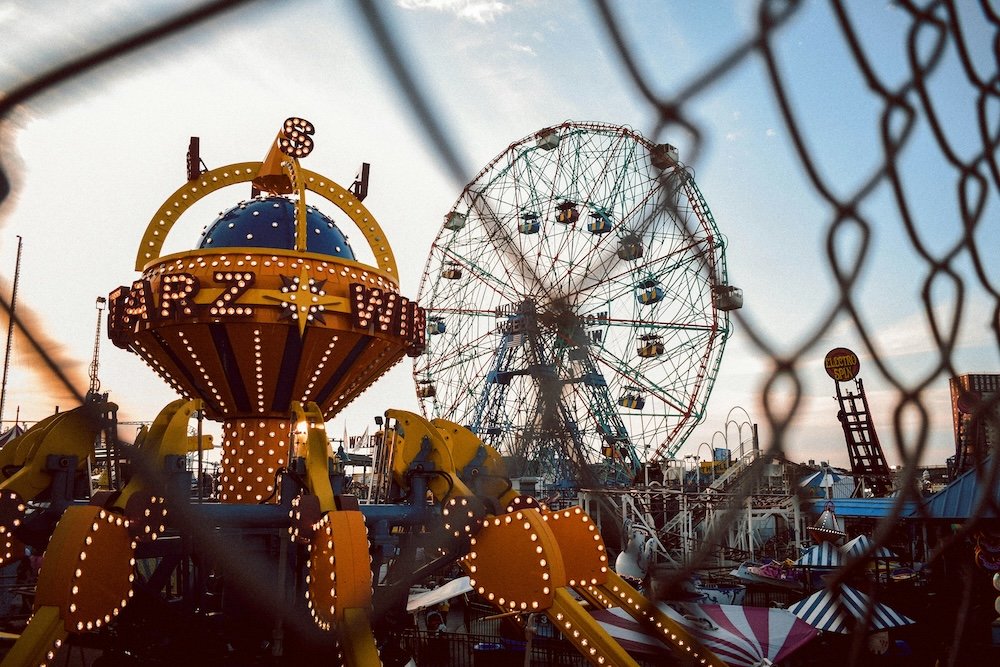
Coney Island is not only famous for its vibrant atmosphere and rich history but also for its unique architectural landmarks that have become symbols of the area’s cultural identity.
Two of the most iconic structures, the Parachute Jump and the Wonder Wheel, stand as testaments to the innovation and enduring charm of Coney Island.
The Parachute Jump: Originally designed as a ride for the 1939 New York World’s Fair, the Parachute Jump found its permanent home at Coney Island in 1941. Often referred to as “Brooklyn’s Eiffel Tower,” this striking structure rises approximately 250 feet high. Although it has not operated as a ride since 1964, the Parachute Jump remains one of the most recognizable landmarks of Coney Island. Its steel frame, once adorned with parachutes that lowered riders from the top, now serves as an iconic silhouette against the skyline. The structure was designated a New York City landmark in 1988 and later refurbished with a lighting system that illuminates it at night, creating a mesmerizing light show that continues to draw the gaze of visitors and locals alike. The Parachute Jump’s historical and architectural significance is a reminder of Coney Island’s past innovations in amusement technology and its ongoing legacy as a seaside entertainment destination.
The Wonder Wheel: Built in 1920, the Wonder Wheel is an engineering marvel and a beloved attraction of Coney Island’s amusement district. This eccentric Ferris wheel stands 150 feet tall and features both stationary cars and unique sliding cars that move along tracks as the wheel rotates, offering riders a surprisingly thrilling experience combined with spectacular views of the Atlantic Ocean and the New York Cityscape. The Wonder Wheel has operated continuously since its opening, weathering the ups and downs of Coney Island’s history and serving as a symbol of its resilience. It was designated an official New York City landmark in 1989, cementing its status as an architectural and cultural icon. Each year, the Wonder Wheel attracts hundreds of thousands of visitors, proving its lasting appeal as a centerpiece of Coney Island’s amusement offerings.
Cultural Impact: The Parachute Jump and the Wonder Wheel are more than just structures; they are integral parts of the community’s identity and have contributed significantly to the cultural landscape of Coney Island. They evoke a sense of nostalgia and continuity, linking the present day Coney Island to its golden age as America’s playground. These landmarks also serve as focal points for photographs, film, and literature, embedding themselves in the cultural fabric of New York City.
Both the Parachute Jump and the Wonder Wheel illustrate how Coney Island’s architectural innovations have created lasting landmarks that not only define the skyline but also embody the spirit of this unique entertainment hub.
As enduring symbols of fun and ingenuity, they continue to captivate the imaginations of visitors and embody the whimsical essence of Coney Island.
Fact 11: Coney Island Today: A Blend of Old and New
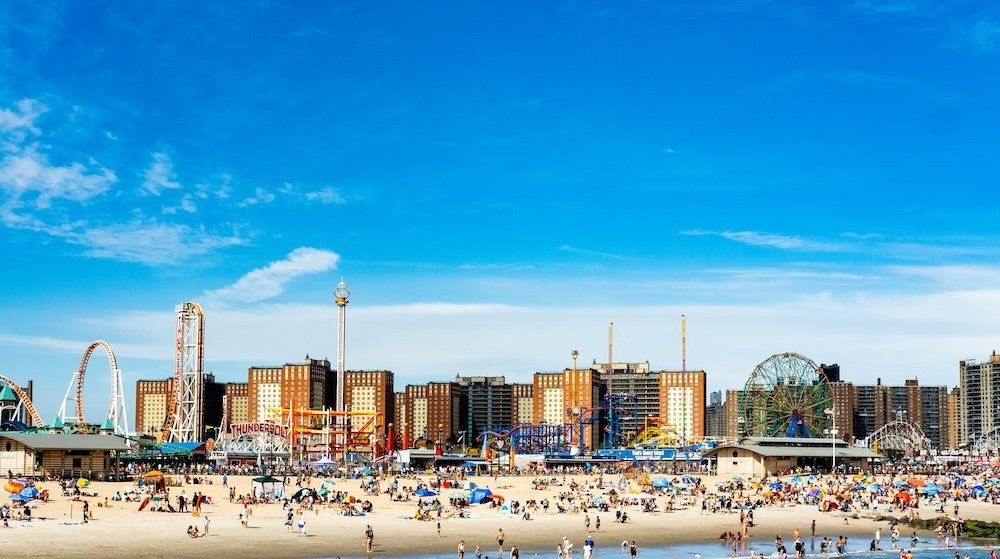
Today, Coney Island represents a dynamic blend of its storied past and vibrant future, maintaining its historic landmarks while embracing modern developments.
This unique juxtaposition makes it a living museum of amusement history as well as a forward-looking entertainment destination that continues to evolve and captivate.
Historic Preservation: Coney Island’s commitment to preserving its history is evident in the meticulous restoration of iconic structures like the B&B Carousell, one of the last traditional carousels in the U.S., which was fully restored and reopened in 2013. Efforts to maintain the Parachute Jump and the continual operation of the Wonder Wheel also highlight the community’s dedication to preserving its cultural heritage. These landmarks are not merely kept for nostalgia but are celebrated components of the area’s ongoing attraction.
Modern Developments: Alongside these historic icons, Coney Island has also welcomed modern attractions that add to its appeal and functionality as a 21st-century entertainment hub. The recent redevelopment efforts have included the opening of new rides and attractions at Luna Park, such as the Thunderbolt roller coaster and the Astro Tower, which offer contemporary thrills to visitors. The revitalization of the boardwalk, along with improved public amenities, reflects a broader trend towards making Coney Island a more comfortable and accessible destination for a diverse array of visitors.
Community and Cultural Events: Coney Island today is also a vibrant cultural hub, hosting a variety of events that celebrate its unique identity and the diversity of its community. The annual Mermaid Parade, for example, continues to draw large crowds and foster a spirit of artistic expression and community engagement. Other events, like free outdoor movies on the beach, music concerts, and food festivals, utilize the scenic backdrop of Coney Island to provide cultural and recreational activities that are accessible to all.
Economic and Social Impact: These developments and events not only boost local tourism but also have a significant economic impact on the community. They support local businesses and provide employment opportunities, contributing to the economic vitality of the area. Additionally, they help foster a sense of community and continuity among residents and visitors alike, who share in the enjoyment and stewardship of Coney Island’s rich heritage.
Looking to the Future: As Coney Island continues to develop, it maintains a careful balance between innovation and tradition, ensuring that its history is not overshadowed by new developments but rather complemented by them. This approach has helped Coney Island remain a beloved destination, drawing visitors from around the world who come to experience its unique blend of old and new.
Coney Island today stands as a testament to the power of adaptive reuse and community involvement in urban entertainment districts.
It is a place where history and modernity coalesce, creating a lively and multifaceted seaside destination that honors its past while continually looking forward to the future.
Conclusion
Coney Island, with its rich tapestry of history, culture, and innovation, remains one of America’s most iconic entertainment destinations.
From its early days as a beachfront resort to its transformation into the birthplace of the hot dog and the American roller coaster, Coney Island has consistently redefined the boundaries of amusement and leisure.
It has served as a beacon of creativity and resilience, standing through times of both prosperity and challenge, and emerging as a vibrant symbol of New York City’s spirit.
The enduring allure of Coney Island lies in its ability to embrace both the old and the new.
Historic rides like the Wonder Wheel and landmarks such as the Parachute Jump coexist with modern roller coasters and vibrant community events, creating a dynamic environment that honors its past while continuously evolving.
This blend of history and modernity makes Coney Island a unique cultural artifact, reflecting the broader narrative of American entertainment and the ongoing story of a community that cherishes its heritage while boldly looking forward.
For anyone seeking to understand the heart of American popular culture, a visit to Coney Island offers more than just amusement—it offers a deep dive into a place where history comes alive, where the thrill of the old intertwines with the excitement of the new.
Whether you are riding one of the classic attractions, participating in the whimsical Mermaid Parade, or simply enjoying a stroll along the iconic boardwalk, Coney Island provides a multitude of experiences that are as enriching as they are entertaining.
We encourage everyone, whether history buffs, thrill-seekers, or families, to explore Coney Island.
Immerse yourself in its eclectic charm, partake in its community events, and let yourself be swept away by the enduring magic of this quintessential American landmark.
Experience firsthand the unique blend of history and modernity that only Coney Island can offer, and be part of the continuing story that makes this place truly legendary.
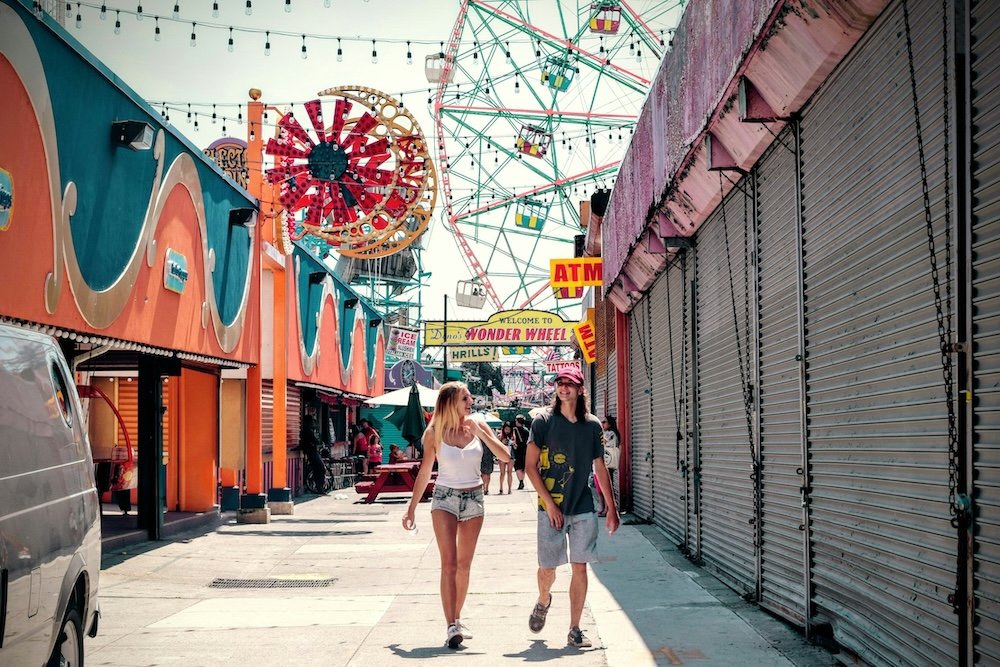
FAQ’s About Coney Island:
Why is Coney Island so famous?
Coney Island is famous for its historic amusement parks, the iconic boardwalk, and its role as a pioneering site of American popular culture.
It has been a symbol of leisure and entertainment since the late 19th century, known for introducing the first roller coasters and the invention of the hot dog.
Its unique blend of beachfront fun, eclectic attractions, and cultural events like the annual Mermaid Parade contribute to its fame.
Is it worth visiting Coney Island?
Yes, Coney Island is worth visiting for a variety of reasons.
It offers a rich mix of historical attractions, such as the Wonder Wheel and the Cyclone roller coaster, alongside newer attractions and amenities.
The beach, boardwalk, and seasonal events provide diverse entertainment options for all ages.
Whether you’re interested in amusement rides, food, history, or beach activities, Coney Island has something to offer.
Why is Coney Island special?
Coney Island is special due to its historical significance as one of the first amusement areas in the United States and its ongoing cultural impact.
It blends a nostalgic feel with modern attractions and remains a living symbol of New York’s cultural diversity and inventive spirit.
Additionally, its community-led events, like the Mermaid Parade, underscore its unique place in American culture as a site of artistic expression and communal gathering.
Do people still go to Coney Island?
Yes, people still go to Coney Island, especially during the warmer months from late spring through early fall.
It remains a popular destination for both locals and tourists, drawn by its historic rides, the beach, annual events, and the boardwalk.
Each summer, Coney Island attracts millions of visitors looking to enjoy its traditional and new attractions.
Why do they call it Coney Island?
Coney Island was originally called “Conyne Eylandt” by the Dutch settlers, which translates to “Rabbit Island” in English, referring to the abundance of wild rabbits that once inhabited the island.
Over time, the name evolved to the anglicized “Coney Island,” maintaining a link to its origins.
What is a fun fact about Coney Island?
A fun fact about Coney Island is that it was the site of the world’s first roller coaster, the Switchback Railway, which opened in 1884.
This simple ride, charging a nickel per ride, laid the groundwork for the development of more complex roller coasters and the amusement park industry as a whole.
How much money do you need for Coney Island?
The amount of money needed for a visit to Coney Island can vary widely depending on your plans.
Entry to the beach and boardwalk is free, but amusement park rides, food, and other activities can cost anywhere from a few dollars to several hundred dollars.
For a day trip, budgeting $50 to $100 per person can cover basic amusement rides, food, and a few games, though this could increase if you plan to experience more attractions or dine at more upscale venues.
How long do you spend in Coney Island?
The amount of time spent in Coney Island can vary, but a typical visit might last from a few hours to a full day. If you’re there to enjoy the beach and a few rides, a half-day might suffice.
For those interested in exploring more extensively, including rides, aquarium visits, and perhaps a show or concert, a full day would be more appropriate.
What is the reputation of Coney Island?
Coney Island’s reputation has fluctuated over the years, from its peak as a premier entertainment destination in the early 20th century to a period of decline mid-century, and a resurgence in recent decades as a revitalized entertainment and cultural hub.
Today, it is generally viewed positively, celebrated for its history, enduring charm, and as a symbol of New York City’s resilience and diversity.
However, it also faces challenges such as economic disparities and the impacts of seasonal tourism on the local community.
